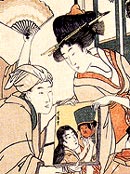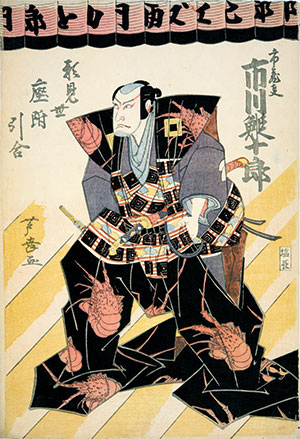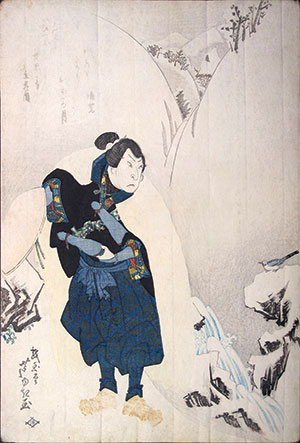

Gigadô Ashiyuki (戯画堂芦幸)
|
 The prolific Gigadô Ashiyuki (戯画堂芦幸), act. 1813–33, who also used the name Nagakuni (長國) circa 1814–21, was an important innovator within the Kamigata tradition of printmaking. A pupil of Kôgadô Ashikuni (act. c. 1801–20), Ashiyuki appears to have been the first to combine Shijô-style painterly elements in single-sheet print design, possibly derived from ehon (woodblock-printed illustrated books) of the period, with the more densely colored ukiyo-e manner of rendering figures. He might have been the earliest Kamigata print artist to use gofun (white shell powder) for snow and to have printers use color blocks without outlines on single-sheet prints. His chûban-format designs and horizontal ôban compositions were among the earliest of their kind in Osaka.
The prolific Gigadô Ashiyuki (戯画堂芦幸), act. 1813–33, who also used the name Nagakuni (長國) circa 1814–21, was an important innovator within the Kamigata tradition of printmaking. A pupil of Kôgadô Ashikuni (act. c. 1801–20), Ashiyuki appears to have been the first to combine Shijô-style painterly elements in single-sheet print design, possibly derived from ehon (woodblock-printed illustrated books) of the period, with the more densely colored ukiyo-e manner of rendering figures. He might have been the earliest Kamigata print artist to use gofun (white shell powder) for snow and to have printers use color blocks without outlines on single-sheet prints. His chûban-format designs and horizontal ôban compositions were among the earliest of their kind in Osaka.
Influenced by his teacher Ashikuni at the beginning of his career, Ashiyuki drew the faces of his actors in the conventional rectilinear manner. One example (see image at right) depicts the Osaka-born Ichikawa Ebijûrô I (1777–1827; formerly Ichikawa Ichizô I) addressing the audience during a "face showing at the introduction ceremony" (kaomise zatsuki hiki-awase, 顔見世座附引合) at the Kado Theater, Osaka, in 11/1815. Four months earlier, while in Edo, the middle-aged actor had been given the name "Ebijûrô" by the superstar Ichikawa Danjûrô VII. Ebijûrô followed up with his first official performance under the new name in the ninth lunar month at the Nakamura Theater, Edo. When newly arrived in Osaka in the fall of 1815, Ebijûrô announced his name change before Osaka kabuki patrons, a milestone occasioning Ashiyuki's print, which reads Ichizô aratame [changing to] Ichikawa Ebijûrô (市蔵改市川鰕十郎). The actor's distinguished hakama (袴 long-legged trousers) was a bespoke design for this special event, as the large prawn (ebi, 鰕) pattern on his robes represents the first character in his new name, Ebijûrô.
 As the conventional style of drawing facial likenesses (nigao) and figures evolved in Kamigata toward more curvilinear forms, Ashiyuki's drawing of faces was no exception, although his physiognomies were characterized by a somewhat exaggerated sharpness. This manner of nigao continued until Ashiyuki's final printmaking years, as in a late work from 1/1832 showing Arashi Rikan II as Miyamoto Musashi (see image at right) in the play Katakiuchi nitô no eiyûki (A tale of revenge and great courage on two islands: 復讐二島英勇記) at the Chikugo Theater, Osaka. In this scene, Rikan exited the main stage by moving along the walkway (hanamichi, 花道) and, at the half-way point, walked and gestured as if descending into a valley. The background in Ashiyuki's design was influenced by the Shijô school's fairly realistic approach toward rendering landscapes.
As the conventional style of drawing facial likenesses (nigao) and figures evolved in Kamigata toward more curvilinear forms, Ashiyuki's drawing of faces was no exception, although his physiognomies were characterized by a somewhat exaggerated sharpness. This manner of nigao continued until Ashiyuki's final printmaking years, as in a late work from 1/1832 showing Arashi Rikan II as Miyamoto Musashi (see image at right) in the play Katakiuchi nitô no eiyûki (A tale of revenge and great courage on two islands: 復讐二島英勇記) at the Chikugo Theater, Osaka. In this scene, Rikan exited the main stage by moving along the walkway (hanamichi, 花道) and, at the half-way point, walked and gestured as if descending into a valley. The background in Ashiyuki's design was influenced by the Shijô school's fairly realistic approach toward rendering landscapes.
The play Katakiuchi nitô no eiyûki was based on the historical Miyamoto Musashi (c. 1584-1645; 宮本武蔵), whose name meant "Storehouse of military knowledge." Also an author, Musashi wrote Gorin no sho (The Book of Five Rings: 五輪書), a treatise on military tactics, strategy, and philosophy. He was a legendary swordsman and the son of the celebrated fencing master Yoshioka Tarozaemon, a retainer of the Ashikaga shôgun Yoshiteru. Musashi was a bold and reputedly reckless adventurer, although he survived armed combat more than 60 times and died a natural death. Katakiuchi nitô no eiyûki was one of many popular tales of vengeance and retribution, an example of the theatrical genre of "revenge plays" called katakiuchi mono (敵討物) or adauchi mono (仇打ち物). In one such incident, Musashi avenged the murder of his father by despatching his killer with a wooden sword, a lethal weapon in the hands of a master swordsman. Musashi's exploits took him into the mountains during winter, when he is often depicted, as in Ashiyuki's design, carrying or wearing a straw hat and padded jacket..
Ashiyuki's names/signatures/seals
Surname:
Possibly Kôzo (楮) in 1823
Art Names (geimei):
Note: Ashiyuki used four different combinations of kanji for his art name:
Ashiyuki (芦幸) c. 1814–19
Ashiyuki (蘆幸) c. 1814–17
Ashiyuki (芦由) c. 1821–23
Ashiyuki (芦雪) c. 1823 (on a seal)
Nagakuni (長國)
One of Ashiyuki's seals reads "Yu": ゆ.
Art Pseudonym (gô):
Gigadô (戯画堂); see image at upper right.
Pupils of Ashiyuki
Ashiyuki's pupils included (in order of known years of activity):
Yukikuni (幸國 act. c. 1816)
Ashiharu (芦陽 act. c. 1824)
Okayodô Ashimaru (岡丈堂芦丸) act. c. 1824)
©1999-2021 by John Fiorillo
BIBLIOGRAPHY
- Keyes, R. and Mizushima, K.: The Theatrical World of Osaka Prints. Philadelphia: Philadelphia Museum of Art, 1973.
- Hendrick Lühl: Schätze der Kamigata: Japanische Farbenholzschnitte aus Osaka, 1780-1880 (Treasures of Osaka: Japanese Color Prints from Osaka, 1780-1880). Musee National d'Histoire et d'Art Luxembourg, 2013.
- Matsudaira, Susumu: Kamigata yakusha-e shûsei (Collection of Kamigata actor prints), Vol. I. Osaka: Ikeda Bunko, 1997, pp. 68-106.
- Matsudaira, Susumu: Kamigata nishiki-e zuroku (Record of Kamigata brocade prints). Konan Women's University, Eds. Kobe, 1997.
- Schwaab, Dean: Osaka Prints. New York: Rizzoli, 1989.
Viewing Japanese Prints |